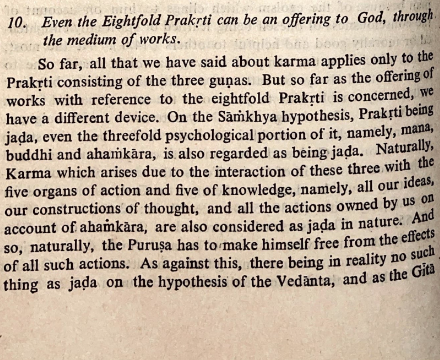So far, all that we have said about karma applies only to the Prakrti consisting of the three gunas. But so far as the offering of works with reference to the eightfold Prakrti is concerned, we have a different device. On the Samkhya hypothesis, Prakṛti being jada, even the threefold psychological portion of it, namely, mana, buddhi and ahaṁkāra, is also regarded as being jada. Naturally, Karma which arises due to the interaction of these three with the five organs of action and five of knowledge, namely, all our ideas, our constructions of thought, and all the actions owned by us on account of ahamkara, are also considered as jada in nature. And so, naturally, the Purusa has to make himself free from the effects of all such actions. As against this, there being in reality no such thing as jada on the hypothesis of the Vedanta, and as the Gita has successfully transformed the nature of Prakrti as a whole into an obedient servant of God, known as Māyā or Aparā Prakṛti or even as a lower kind of Purusa known as Kşara Puruşa, Karma also cannot remain as a dead load on the shoulders of man. We have seen above as to how Karma, when it is used as an offering in the fire of Brahman, becomes one with Brahman. We have also seen how the mind and buddhi can make it sättvika in nature after eschewing the rajasa and the tamasa aspects of it. Even the element of ahaṁkāra would help to stabilize the sattvika character of karma, provided the ahaṁkāra is of a sattvika nature. For instance, as Ramadāsa holds, the ahamkara of what is true, beautiful, good and real is, as good as absence of ahaṁkāra.
The question however as to how the jada or the inconscient nature of the remaining five parts of Prakṛti, namely the five elements of earth, water, fire, air and ākāśa can be changed and made use of in making the works as offerings to God is as novel as it is interesting. This fivefold part of Prakrti which looks inert and passive is very cleverly shown by the Gita as hiding within it a core of Caitanya or divine life. “I am the divine smell (punyo- gandhah) within the earth; the lustre (tejas or prabha) in the Sun, the moon and the fire; the flavour (rasa) in water; and sound (śabda) in ākāśa (7.8-9). “They are the ‘tanmātras’ or the essences and not the qualities of the five elements; nor are they abstracted from the qualities which have the same names of the tanmatras, and which are considered as belonging to the five elements known as substances. It must be remembered that it is the tanmatras which are the source of both the substances and their qualities. They are the first in being, though they are known after their products, namely, the elements and their qualities are known. Hence, what the Gita obviously intends us to do is to realize these tanmatras as the only reality at the back of all our sensuous experience, and thus to go beyond the alluring influence of the sensuous qualities of the elemental substances of which not only the objects of the senses are formed, but also our own bodies and senses. To illustrate: if one is fortunate to enjoy the flavour of the divine Name, he would try to mingle with it the flavour of the food he eats. Even his coarse food would then give him the delight of having eaten rich food. Then, will the general, indifferent attitude towards one’s routine dinner will be changed into one of joyful expectation and of gratitude to God for having given his daily bread. Similarly, he may be gifted to sing with a melodious voice and to produce sweet notes on the musical instruments; but, if he be further gifted to hear the ‘unstruck sounds of divine music, he would try to bring the former in line with the latter and thus enrich the quality of his art. Similarly, again, all his activities and reactions with reference to sensuous beauty, he will try to associate and assimilate with the non-sensuous, divine beauty, grandeur and lustre which he sees in the object of his spiritual experience, and which, as the Gita says, is the source of the light and lustre of the Sun, the moon, and the fire. It is in this manner that the qualities of the sensible five parts of Prakrti are capable of being seen in their original form; and so, activities or works connected with them will be found as informed by the Spirit of God.

